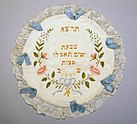|
Challah cover A 'challah cover' is a special cloth used to cover the two braided loaves (Hebrew: חַלָּה, challah; pl. Hebrew: חלוֹת, challot) set out on the table at the beginning of an Ashkenazi Shabbat or Yom Tov meal. While its appearance lends a decorative and ceremonial aspect to the set table, its presence serves both a halakhic and symbolic function. Description  Challah covers may be made from any kind of fabric or paper. They are often hand or machine-embroidered, painted, appliqued or tie-dyed. They are sometimes adorned with fringes interwoven with silver or gold thread. The challah cover must be large enough to cover two braided loaves without allowing the bread to be seen through the sides, and opaque enough so that the loaves cannot be seen through the fabric. Store-bought challah covers often bear the inscription לכבוד שבת קדש ("To honor the holy Shabbat") or לכבוד שבת ויום טוב ("To honor Shabbat and Yom Tov"). Halakhic functionAt the beginning of a Shabbat or holiday meal, a blessing (Kiddush) must preferably be made over the wine first in order to sanctify the Shabbat.[1] This is followed by the blessing over the bread (challah), which begins the meal. However, in the hierarchy of blessings mandated by the Sages,[2] the blessing over bread should precede the blessing over wine. In order to preserve the priority of the wine, and not to "shame" the bread which should be blessed first,[3] the bread is “removed” by concealing it from view with the challah cover. In the absence of a challah cover, one may use a napkin, doily, tissues, or similar covering.[4] SymbolismRemembrance of the mannaThe placement of the challah under the challah cover and over the Shabbat tablecloth (or over a challah cutting board) also recalls the Biblical scene of the manna which the Israelites ate every day following the Exodus from Egypt. When Moses told the people about the manna, he said that it would fall for them every day of the week. However, in deference to the holiness of Shabbat, the manna would not fall on that day. Instead, two portions of manna would fall on Friday, enough for that day and for the Shabbat (Exodus 16:22-26). This is given as the reason for the use of two braided loaves at Shabbat and holiday meals, as the challot represent the double portion of manna that fell in honor of Shabbat. Each morning the Israelites found the manna in the fields, encased in two layers of dew to preserve its freshness. Rashi describes the way the manna was found:
Thus, we place the challot beneath a challah cover and over a tablecloth (or challah board) to recreate the miracle of the manna at our own Shabbat tables.[6] History In Talmudic times, food was served to banquet guests on three-legged trays rather than tables. These trays were brought to each guest by waiters. On Shabbat, the trays would be brought out only after the Kiddush, to show that the meal was being served in honor of the Shabbat, which had just been sanctified by the recital of the Kiddush.[7] Today, Ashkenazi Jews set the table with the challah, but cover it until the time when it would have been carried in, in Talmudic times. This demonstrates that the meal only begins after — and because of — the Kiddush.[8] Covering the challah so as not to "shame" it while the wine is being blessed has been cited as an object lesson for the importance of not shaming one's fellow humans. The following story is told about Rabbi Yisroel Salanter:[9]
Matzo coversAt the Passover seder, the matzos are also covered. Ashkenazi Matzo covers differ from challah covers in that they can contain three "pockets" into which the three matzos (set out at the beginning of the Seder) are inserted.  According to the Gemara, matzo is called lechem oni (poor man's bread);[10] the Hebrew word oni (עוני) can also be construed as "answers," yielding, "bread upon which answers are spoken."[11] Thus, the matzos are uncovered during the telling of the story of the Jews' servitude in Egypt. However, when the wine cups are raised to express praise to God for the redemption, the matzos are covered so that they will not be "shamed", as one is giving preference to the wine.[12] References
Further readingWikimedia Commons has media related to Challah covers.
|